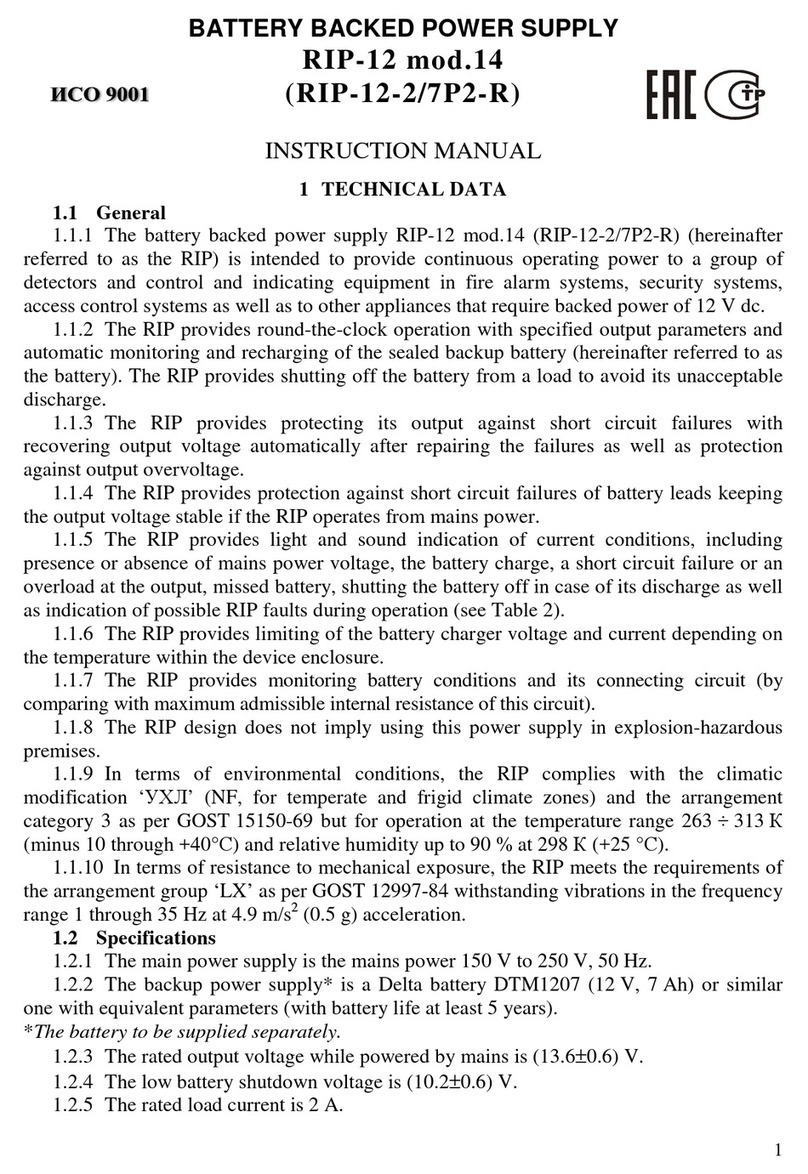SHUTTING OFF RIP-24
1. Shut off the mains power supply 220 V.
2. Detach the batteries.
3. Remove the fuse F1.
4. Disconnect the load circuit.
MAINTENANCE
The maintenance of the RIP-24 is to be carried out annually. The maintaining operations include:
1) Visual inspection of the RIP-24 to discover mechanical injures and to clean any dirt or dust if presented.
2) Checking the output voltage value when the load is connected as specified in SPECIFICATION and checking
the output voltage value when the RIP-24 is powered by batteries.
3) Testing LED and sound indication to meet the requirements of Table above.
4) Inspection of proper attaching of the RIP-24, tightening of contacts, and wire integrity.
5) Replacing the batteries when necessary but at least once per 5 years.
MANUFACTURER
ZAO NVP BOLID
#4, Pionerskaya Str., Korolev, Moscow Region, Russia, 141070
Tel./fax +7 495 775-71-55
BATTERY BACKED POWER SUPPLY
RIP-24 model 01
INSTRUCTION MANUAL
GENERAL
Battery Backed Power Supply RIP-24 model 01 (referred to as RIP-24 below) is designed to provide electric power
to various fire and intrusion detectors as well as control and indicating equipment suited for uninterrupted 24 VDC.
The RIP-24 is round-the-clock operating device with specified output parameters and sealed backup batteries which
are tested and charged automatically. The RIP-24 provides shutting the batteries off from the load circuit to avoid their
unacceptable discharge.
The RIP-24 provides light and audible indication of its current status, i.e. normal or no voltage, battery charge,
output short failure or overload, battery missing or shutting down when discharged.
Being powered by mains power and by backup batteries, the RIP-24 provides its outputs against short circuit
failures with automatic recovering output voltage after repairing the failures.
When operated, the RIP-24 should be protected against atmospheric fallout and mechanical damage. RIP-24 is not
designed to be used in explosion-hazardous premises.
SPECIFICATION
AC Input Voltage Range: (220+22-33) VAC
Backup Power Supply: twobatteries «Delta» DTM1207 12 V @ 7 Ah or analogous
(with the lifetime of at least 5 years)
No batteries are provided with the power supply
Output Voltage Range: 27.0 ±1.2 VDC at both AC and charged battery powering;
22.0 ±1.0 VDC min provided the battery is discharged
Load Current Rating: 3.0 А
Maximum Load Current: 4.0 Аfor 2 min, once an hour, at both mains and battery power
Input Current Consumption: 0.7 A max at rating load
RIP-24 Consumption From the Battery: 30mAmax
Ripple (mVp-p)×2: 30 mV maximum at rating load current
Battery Low Shutdown: 20.4±1.2 VDC
On Battery Run-Time: at least 5 hours for 1 A load current at 25°C
(the run-time increases in inverse proportion to the load current)
Pre-Operation Time: 3 seconds max
Operating Temperature Range: from –10°C to +40°C
Relative Humidity: up to 90% at +25°C
Overall Dimensions: 340 mm × 270 mm × 100 mm
RIP With Batteries Weight: 12 kg maximum
Typical Lifetime: 10 years, the batteries being to be replaced once every5 year
The RIP-24 provides outputting a signal to the NPN output in case of switching to powering by the backup batteries
(in state of no mains power) or a short failure in the load circuit. The NPN output is opened when AC line fails and
the RIP-24 is operating in battery mode or in case of a short load circuit failure, and it is closed when the RIP-24 is
powered by mains power. The maximum NPN output permissible voltage and commutation current are 30 V and
100 mA respectively.
The RIP-24 provides connecting two extra 12 V batteries of 17 Ah each placed in a special Box 2x17Ah to increase the
timeof operation from the batteries (with total capacityof allRIP-24 batteries beingequal to2×24 Ah).
STANDARD DELIVERY
Battery Backed Power Supply RIP-24 mod.01 1
Instruction Manual 1
Fuse 2А1
Round Head Wood Screw 3
Wall Plug 3
Plastic Bushing 2
Wire 1
Lock Key 2





















